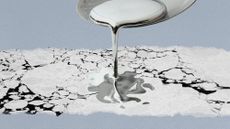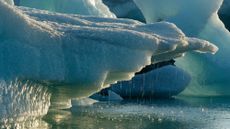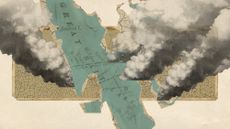Iceberg A23a is taking a spin
As the iceberg turns, so too does its effect on the neighboring ecosystem


The world's largest iceberg, A23a, is spinning north of Antarctica and it probably will do so for a long time. The block of ice is caught in a swirling ocean current caused by an obstruction on the ocean floor. Over time, the rotating iceberg could affect the ecology of the region as it slowly melts and erodes.
A case of the spins
The A23a iceberg is four times the size of New York City. It broke from the Antarctic coastline in the 1980s but got stuck to the floor of the Weddell Sea. There it stayed until 2020 when it freed itself and began drifting. Now, the "megaberg is in its spinning era," said the British Antarctic Survey on X. A23a entered the Antarctic Circumpolar Current (ACC), which would normally cause the berg to move faster. However, it has instead got caught up in a Taylor column, a type of vortex.
A Taylor column occurs when a current "meets an obstruction on the seafloor," and under the right circumstances can "separate into two distinct flows, generating a full-depth mass of rotating water between them," said the BBC. "In this instance, the obstruction is a 100km-wide bump on the ocean bottom known as Pirie Bank. The vortex sits on top of the bank, and for now A23a is its prisoner."
Subscribe to The Week
Escape your echo chamber. Get the facts behind the news, plus analysis from multiple perspectives.

Sign up for The Week's Free Newsletters
From our morning news briefing to a weekly Good News Newsletter, get the best of The Week delivered directly to your inbox.
From our morning news briefing to a weekly Good News Newsletter, get the best of The Week delivered directly to your inbox.
"It's basically just sitting there, spinning around, and it will very slowly melt as long as it stays there," Alex Brearley, the head of the Open Oceans research group at the British Antarctic Survey, said to The New York Times. "What we don't know is how quickly it will actually come out of this." Scientists expect that "if A23a spends an extended time in the vortex, the iceberg could melt significantly and affect plankton and other organisms in the marine food chain." Eventually, the iceberg will move to warmer waters and gradually melt.
An icy reception
While A23a breaking off into the sea is not necessarily a concern, the Antarctic is seeing the effects of climate change. "These big icebergs are spectacular, but they're just the way Antarctica works. This is how an ice sheet works. It gathers snow, and the snow thickens and flows off into the ocean, and then pieces break off," Ted Scambos, a senior research scientist at the University of Colorado Boulder, said to NPR. "And in Antarctica, those pieces are really, really large." When it comes to A23a, the "time had just come," Andrew Fleming, a remote sensing expert from the British Antarctic Survey, said to the BBC.
But the "increasing rate of iceberg calving in Antarctica raises concerns about the stability of ice shelves and the potential for accelerated sea-level rise," said Earth.com. Melting glaciers are a growing problem contributing to sea level rise across the world. According to the NASA Earth Observatory, Antarctica hit a record low for sea ice in February 2023, with even more stark ice loss in the Arctic.
Icebergs can greatly affect marine ecosystems, serving both as creator and destroyer. An iceberg like A23a can shed nutrients it "accumulated from Antarctica" and stir up "deep water, possibly sparking a plankton bloom in its wake," and such an iceberg can also "scrape and scour the seafloor in shallow waters," wrecking the ecosystem, said NPR.
Create an account with the same email registered to your subscription to unlock access.
Sign up for Today's Best Articles in your inbox
A free daily email with the biggest news stories of the day – and the best features from TheWeek.com
Devika Rao has worked as a staff writer at The Week since 2022, covering science, the environment, climate and business. She previously worked as a policy associate for a nonprofit organization advocating for environmental action from a business perspective.
-
 The week's best photos
The week's best photosA helping hand, a rare dolphin and more
By Anahi Valenzuela, The Week US Published
-
 Today's political cartoons - August 30, 2024
Today's political cartoons - August 30, 2024Cartoons Friday's cartoons - seasoned vets, football season, and more
By The Week US Published
-
 'Harris gains slim lead'
'Harris gains slim lead'Today's Newspapers A roundup of the headlines from the US front pages
By The Week Staff Published
-
 The Arctic is a ticking 'mercury bomb'
The Arctic is a ticking 'mercury bomb'An icy prison break is on the way
By Devika Rao, The Week US Published
-
 Bananas have been facing extinction. But maybe not for much longer.
Bananas have been facing extinction. But maybe not for much longer.under the radar Scientists may have a solution for a longstanding fungus problem
By Devika Rao, The Week US Published
-
 Homeowners are getting burned by solar panel scammers
Homeowners are getting burned by solar panel scammersIn Depth One-star reviews for solar companies have increased over 1,000% since 2018
By Justin Klawans, The Week US Published
-
 China's winning battle against desertification
China's winning battle against desertificationUnder The Radar Beijing is using solar power to lead the fight as climate change intensifies the threat
By Chas Newkey-Burden, The Week UK Published
-
 11 looming climate tipping points that imperil our planet
11 looming climate tipping points that imperil our planetThe Explainer New reports detail the thresholds we may be close to crossing
By Devika Rao, The Week US Published
-
 The world's largest tropical wetland is on fire, and under threat from waterway
The world's largest tropical wetland is on fire, and under threat from waterwayUnder the Radar Proposed shipping route through Pantanal in Brazil could dry out biome and worsen devastating wildfires
By Harriet Marsden, The Week UK Published
-
 Why lithium mining has Serbians up in arms
Why lithium mining has Serbians up in armsUnder the Radar Balkan nation has reinstated controversial licence to extract 'white gold' as race for crucial EV mineral intensifies
By Harriet Marsden, The Week UK Published
-
 The Great Salt Lake is getting less great by the year
The Great Salt Lake is getting less great by the yearUnder the radar Evaporation is wrecking havoc on the local ecosystem
By Devika Rao, The Week US Published